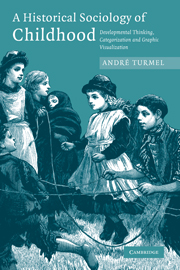 A Historical Sociology of Childhood
A Historical Sociology of Childhood Book contents
- Frontmatter
- Contents
- List of illustrations
- Acknowledgements
- Introduction
- 1 Children in the collective
- 2 Graphs, charts and tabulations: the textual inscription of children
- 3 Social technologies: regulation and resistance
- 4 The normal child: translation and circulation
- 5 Developmental thinking as a cognitive form
- Conclusion
- Appendix
- Bibliography
- Index
5 - Developmental thinking as a cognitive form
Published online by Cambridge University Press: 22 September 2009
- Frontmatter
- Contents
- List of illustrations
- Acknowledgements
- Introduction
- 1 Children in the collective
- 2 Graphs, charts and tabulations: the textual inscription of children
- 3 Social technologies: regulation and resistance
- 4 The normal child: translation and circulation
- 5 Developmental thinking as a cognitive form
- Conclusion
- Appendix
- Bibliography
- Index
Summary
By the 1920s and 1930s, development was not only an outlandish idea emerging from researchers in isolated laboratories. It was, more broadly, becoming both a way of thinking and acting legitimized in the scientific community and in the larger childhood collective; thus, slowly percolating several activities pertaining to childhood. Growth, which chiefly means children's physical progression, was not any longer the central concern in the collective for the questions of hygiene, nutrition and so on were already on the agenda of experts and families, and mental hygiene was likewise becoming a crucial aspect of children's lives, therefore extending widely the emerging concept of development.
It is understood that developmental thinking paved the way to the idea of the normal child, to which it is tied by numerous connections, as much mental and physical normality with respect to the child's maturation. Based on statistical technologies in extensive focused enquiries, large-scale regularities contributed decisively to outline what a normal child would look like, both physically and mentally. Although normality was far from being unequivocal as a notion, different actors from the childhood collective – parents, teachers, paediatricians, nurses and welfare activists, social workers – started to be on the look-out for new criteria that would be suitable for adults in their daily relations with children. Developmental standards were implemented in the collective; thus, children's progression was measured in accordance with these standards. Moreover, parents, teachers and the like gradually fell in line with this particular way of thinking.
- Type
- Chapter
- Information
- A Historical Sociology of ChildhoodDevelopmental Thinking, Categorization and Graphic Visualization, pp. 248 - 302Publisher: Cambridge University PressPrint publication year: 2008


